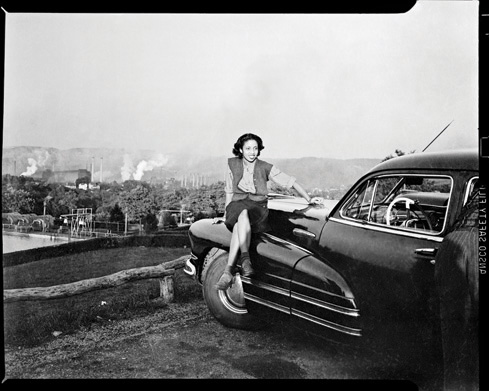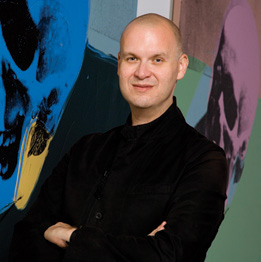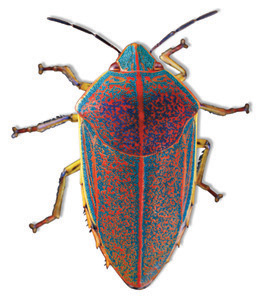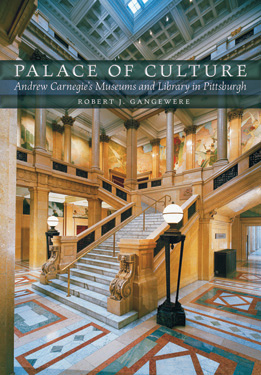 Fall 2011
Fall 2011
Andy Warhol used his signature silkscreening technique to create unforgettable images of larger-than-life personalities such as Marilyn Monroe and Chairman Mao, and to turn once forgettable commercial objects— think Campbell’s soup cans and Brillo boxes—into Pop artifacts. Now, using the Warhol: D.I.Y. POP application, anyone with an iPhone, iPad, or iPod Touch (a version for the Droid is on its way) can digitally apply this Pop magic, “Warholizing” any photograph. The addictive process allows users to crop, expose, paint, and even pull a virtual squeegee all in the pursuit of applying Warhol’s famous style, step-by-step, to a favorite image. Short videos provide an insider’s view of the real-world technique and tools used to achieve it. “I feel Warhol would have embraced and celebrated this technology,” says Tresa Varner, The Warhol’s curator of education who developed the app in partnership with other Warhol colleagues and Carnegie Mellon University’s Professional Software Engineering Program. “He often said he wanted to be a machine. In a 1960s interview, Warhol was asked how he would meet the challenge of automation, and he replied, ‘By becoming part of it.’”
Charles “Teenie” Harris, Woman, possibly Doris Clark, seated on car with steel mill in background, c. 1940–1946, Heinz Family Fund, Teenie Harris Archive © 2006 Carnegie Museum of ArtTraveling TeenieA large-scale traveling exhibition devoted to the works of Charles “Teenie” Harris will debut at Carnegie Museum of Art on October 29 with the help of a $250,000 grant from the National Endowment for the Humanities (NEH). The retrospective Teenie Harris, Photograher: An American Story will celebrate the 40-year career of the Pittsburgh native who produced nearly 80,000 images documenting daily life in the city’s black communities. Harris was a longtime photojournalist for the Pittsburgh Courier, one of the oldest and most prestigious black newspapers in the country. For the first time since acquiring Harris’ archives, the Museum of Art is assembling an exhibition of nearly a thousand of his most memorable and historic images featured as life-size projections accompanied by a newly commissioned jazz soundtrack. In the grant award, NEH advisory panelists lauded the exhibition for its contributions to public understanding of the urban black experience and black life during the Jim Crow and Civil Rights eras. After its Pittsburgh unveiling, a portion of the retrospective will travel as a smaller exhibition of prints to the Birmingham Civil Rights Institute in Alabama and the Atlanta University Center Robert W. Woodruff Library in Atlanta, Georgia. “Teenie Harris had great empathy with his subjects and a talent for storytelling,” says Louise Lippincott, Carnegie Museum of Art’s curator of fine arts and organizer of An American Story. “We hope that through this retrospective and traveling exhibition, he’ll be established in the canons of art, history, and photography.”
One week after The Warhol opened its doors in 1994, Eric Shiner was hired as an intern, charged with sifting through boxes that Andy Warhol marked “fashion” and stuffed to the brim with a fascinating mix of shirts, belts, and leather jackets he either wore or collected. Fourteen years later, after successful stints as a curator in Japan and New York City, the New Castle native returned to The Warhol as its Milton Fine Curator of Art. Then, this past July, Shiner came full circle when he was named director of the museum that today is still unpacking Andy. “It both humbles and excites me to be given the honor of promoting Andy Warhol and his legacy while doing my part to help The Warhol, Carnegie Museums, and Pittsburgh shine,” says Shiner, who served briefly as the museum’s acting director after Tom Sokolowski, The Warhol’s longtime director, stepped down late last year. With a bachelor’s degree in the history of art and architecture and Japanese language and literature at the University of Pittsburgh’s Honors College under his belt, Shiner had followed his heart to Japan. There he earned a master’s degree in the history of art and his chops as an up-and-coming curator, most notably as assistant curator of the 2001 Yokohama Triennale, a robust survey exhibition of contemporary art similar to Carnegie Museum of Art’s Carnegie International. Lured back to the States by a Yale Ph.D. program, Shiner instead earned a second master’s degree and left for his next great adventure: the New York City art world, where he curated shows such as Making a Home: Japanese Contemporary Artists in New York at Japan Society. Today, Shiner is an active writer, lecturer, and genuine man-about-town known for his friendly and collaborative spirit. In Shiner, Carnegie Museums found a director “who is at once scholarly and refined, yet populist and welcoming—not unlike the dichotomous art of Andy Warhol himself,” says John Wetenhall, president & CEO of Carnegie Museums.
Carnegie Museum of Natural History is collaborating on a first-of-its-kind project that will give experts and amateurs alike a three-dimensional online look at some 56 million insects. Entomologist extraordinaire John Rawlins and his team in the museum’s section of invertebrate zoology are part of a group of scientists from 13 American universities currently working to digitize—identify, photograph, and post online—insect collections at 22 Midwestern institutions. This irreplaceable resource will document 160 years of environmental change currently inaccessible to scientists and the public. It’s all happening thanks to a $10 million digitizing initiative by the National Science Foundation, which is funding the creation of InvertNet: An Integrative Platform for Research on Environmental Change, Species Discovery, and Identification, an online museum that will capture and distill information from invertebrate specimens on land-use changes of the Great Lakes and upper Mississippi River drainage basins. Carnegie Museum of Natural History received $225,000 in support of its portion of the project.
Told through the eyes of a longtime insider and gifted storyteller, the far-reaching history of Andrew Carnegie’s lasting gifts to the Steel City and their worldwide influence comes to life in Palace of Culture, Andrew Carnegie’s Museums and Library in Pittsburgh. Published by University of Pittsburgh Press and written by Robert J. Gangewere, former adjunct professor of English at Carnegie Mellon University and former editor of CARNEGIE magazine for three decades, Palace of Culture is a thorough look at the life and times of Andrew Carnegie’s Carnegie Institute, which today comprises four distinctive museums and a separately operated system of libraries. “It makes for a fascinating account that not only is a tribute to Andrew Carnegie’s vision but also demonstrates that libraries, museums, and concert halls can have a powerful, even transformative impact on cities,” says Petra Chu, professor of art history at Seton Hall University. In his 2004 farewell note in CARNEGIE magazine, Gangewere promised to tackle this important project by sharing unforgettable stories—like when Carnegie, sitting on a log in Cresson, Pennsylvania, first told minister William Holland that he wanted to do something special for Pittsburgh, like build a library. “It’s a very American story with no simple parallel in the larger world of museums,” Gangewere wrote. “I can’t wait to tell it.” After scores of interviews and unprecedented research, Gangewere has accomplished his goal. Join Gangewere for one of his scheduled talks about his book: October 18 from 3-5 p.m. in the Carnegie Museum of Art Theater; November 9 from 7-9 p.m. at Ligonier Public Library; and January 14, 2012, from 2-4 p.m. at Carnegie Library of Pittsburgh in Oakland.
|
In Praise of the Superhero · For the Birds … and the Environment · Picturing Pittsburgh · The STEM solution · Directors' Note · Face Time: Kristoffer Smith · Science & Nature: Big on Brains · Artistic License: Architectural Wonder · First Person: Summer Dreaming · The Big Picture
 |
Copyright © 2017 CARNEGIE Magazine. All rights reserved. |





